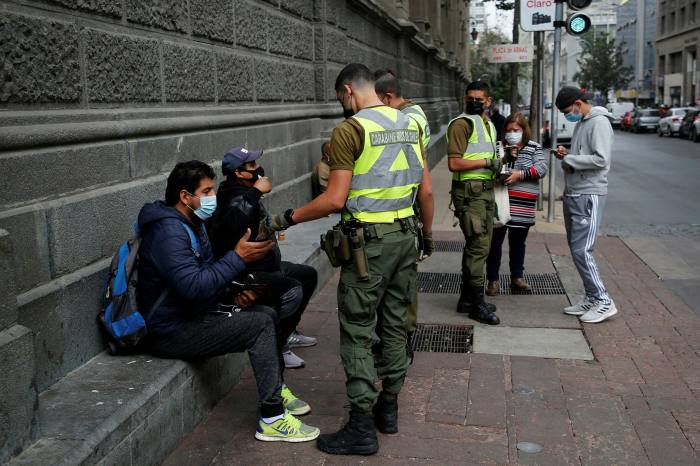[ad_1]
Scarcely a month ago, Chile’s centre-right government was basking in praise for its model rollout of Covid-19 vaccines, as it powered ahead of the rest of the Latin America — and most of the world.
But since then, the mood in Santiago has darkened. Chile’s impressive vaccine programme has failed to spare it from a recent surge in coronavirus cases in the region, which have at least doubled in Chile and most neighbouring countries during the past few weeks.Â
“Nowhere are infections as worrisome as in South America, where cases are mounting in nearly every country,†Carissa Etienne, director of the Pan American Health Organization (PAHO), told a news conference on Wednesday.Â
Despite Chile’s high rates of vaccination, experts say more infectious variants of the virus, a relaxation of social distancing and increased mobility have contributed to the increase in cases, illustrating how vaccination alone is not a panacea.

“We weren’t expecting an impact [of vaccines on infections] until June or even July,†said Miguel O’Ryan, a professor at the University of Chile’s medicine faculty who sits on the Chilean science ministry’s coronavirus vaccine advisory committee. “What we are seeing now is simply — and tragically — what happened in all of the northern hemisphere, with a few exceptions, as autumn started [six months ago].â€
Local experts say the leap in infections in Chile is unlikely to be a consequence of the efficacy rate of China’s Sinovac vaccine, which more than 90 per cent of those who have been vaccinated have been given. Other vaccines are now arriving in greater quantities.
Brazil’s Butantan Institute announced in January that Sinovac’s CoronaVac vaccine had a general efficacy rate in its trials of 50.4 per cent, only just above the 50 per cent minimum threshold for a vaccine to be considered viable. However, it was found to be 100 per cent effective at preventing serious cases that require hospitalisation or intensive care.

Jarbas Barbosa, the PAHO’s assistant director, agrees that vaccination programmes will have a delayed effect, because as much as 70-80 per cent of the population needs to be immunised to prevent the virus from spreading. “We really don’t know yet what is the level that will provide . . . herd immunity,†he said, adding that it was therefore “crucial to keep all the measures [in place] that can prevent transmissionâ€.
For Ximena Aguilera, an epidemiologist on the Chilean health ministry’s advisory council, there are three broad reasons for the jump in daily coronavirus cases in Chile from fewer than 3,500 in late February to about 7,000 now.
First has been the spread of new, more virulent strains of the virus, particularly from Brazil. Second, Chileans have been moving about more after returning from summer holidays in March. And third, she said there had been less strict adherence to social distancing, partly because people felt safer owing to the vaccination programme — but also because of lockdown fatigue.Â

In addition, the Sinovac vaccine is only fully effective after the second dose, unlike the BioNTech/Pfizer vaccine that is much more effective after just one. Although about 40 per cent of Chileans have received one dose so far, less than half that amount have had two. A recent study of the effectiveness of Chile’s vaccination programme found that two weeks after receiving a second jab, it is 56 per cent effective, but with one jab effectiveness drops to just 3 per cent.Â
“The government was over-optimistic in believing that its successful vaccination programme would avoid a new wave of infections,†said Eduardo Engel, an economist who co-authored the report, explaining that in early February the government gave the impression that one dose was likely to have a significant effect.Â
“That led to people getting too relaxed, while the government was not very strict at implementing restrictions. The other factor is that the government did little to stop new variants entering the country, even though it knew since December that it was a major risk factor,†he added.
O’Ryan pointed out that although the steep upward curve of cases in Chile may look alarming, the death toll is not rising as sharply as it did in the first wave, which peaked in June last year. That is because the most vulnerable have been vaccinated, with fewer elderly people in intensive care units — they are mostly adults in their 40s and 50s, who were less likely to die from Covid, he said.Â

But only when vaccinations reach the most mobile group of the population most likely to spread the virus — people aged between about 20 and 55 — would cases begin to decline significantly, he added.
Mercedes López Nitsche, director of the immunology department at the University of Chile, emphasised that there was “no magic wand†when it comes to handling pandemics. “To think that the whole solution can rely on just one strategy is a conceptual error,†she said, arguing that a vaccination programme, however, successful is not enough.
The PAHO’s Etienne made a similar point. “Vaccines are just one part of our Covid response — and we must continue to rely on public health measures to keep our populations and our countries safe,†she said.
[ad_2]
Source link






